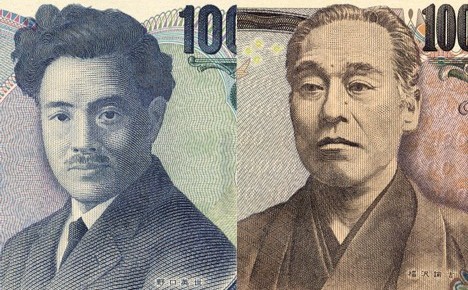
Do these fellows look old enough to smoke? Yes indeed, say Japan's cigarette vending machines that use face-recognition technology to determine the age of the purchaser.
Just two weeks after a major sports paper reported that magazine photos could be used to fool vending machine age-verification cameras, an even more surprising flaw has come to light. The portraits of Hideyo Noguchi and Yukichi Fukuzawa printed on the 1,000-yen and 10,000-yen bills can be used to trick the high-tech machines, according to a new report on the Sankei Shimbun website.
On July 1 -- the day that Japan's cigarette vending machine age-verification system was rolled out nationwide -- Sankei reporters in Tokyo went out in search of machines equipped with age-verification cameras. They found that these machines treated them as adults and allowed them to purchase cigarettes when they showed the portrait of Yukichi Fukuzawa (the renaissance man and Keio University founder who appears on the 10,000-yen note) to the vending machine's camera-embedded mirror. The machines also reportedly sold cigarettes to the portrait of Hideyo Noguchi (the notable bacteriologist who discoveredcontributed to the understanding of syphilis), which appears on the 1,000-yen note.
Once the machines approved the sale, the reporters then used the same money to pay for the purchase, making this all-in-one technique even more convenient than the recently discovered magazine photo trick.
Ironically, news of this latest discovery comes just days after the Finance Ministry officially approved the use of face-recognition technology to determine the age of vending machine users.
Sankei contacted the Finance Ministry's Tobacco and Salt Industries Office about the flaw they found. A surprised official responded by saying, "This is the first we've heard of it. It's a big problem if it's true."
The official said he would immediately notify Fujitaka, the vending machine manufacturer who developed the age-verification camera system. Fujitaka is reportedly in the process of upgrading its face-recognition technology so that it can more effectively distinguish photographs from real people.
Of Japan's more than 500,000 cigarette vending machines, around 4,800 (less than 1%) are equipped with age-verification cameras. The rest are outfitted with readers that check Taspo age-verification cards, which are available to anyone of legal age who applies (though they have yet to become widespread). The vending machines that use age-verification cameras allow people to purchase cigarettes without a Taspo card, as long as they look older than 20 years of age.
[Source: Sankei Shimbun]

Coligny
You took quite some shortcuts about syphilis...
Discovery of the Bacteria
In 1903 Russian biologist Elie Metchnikoff (1845-1916) and French scientist Pierre-Paul-Emile Roux demonstrated that syphilis could be transmitted to monkeys. With this capability, the disease could be studied in the laboratory. Two years later, German zoologist Fritz Schaudinn and his assistant Erich Hoffmann isolated the bacterium that causes syphilis. Schaudinn and Hoffmann showed it to be a spiral-shaped spirochete called Treponema pallidum.
Salvarsan
In 1904 German researcher Paul Ehrlich (1854-1915) and Japanese bacteriologist Sahachiro Hata began looking for a safe, effective treatment for syphilis. They tested hundreds of derivatives of atoxyl, eventually discovering one that worked. Ehrlich called the derivative "Salvarsan." Following trials of the substance on humans, Ehrlich and Hata announced in 1911 that the drug was an effective cure for syphilis. The drug attacked the bacteria without harming healthy cells.
(http://www.discoveriesinmedicine.com/Ra-Thy/Syphilis-Test.html)
[]Michael
Is this only for cigarettes or are they planning on putting them on the sake machines too?
[]Fran
Oh, come on.
If I had my tin foil hat on, I'd say this is one of the most clever campaigns ever to get young people to play with cigarette machines. I'd raise a brow at how the blogosphere has helped Mr. Nicotine to spread his subliminal ads.
[]